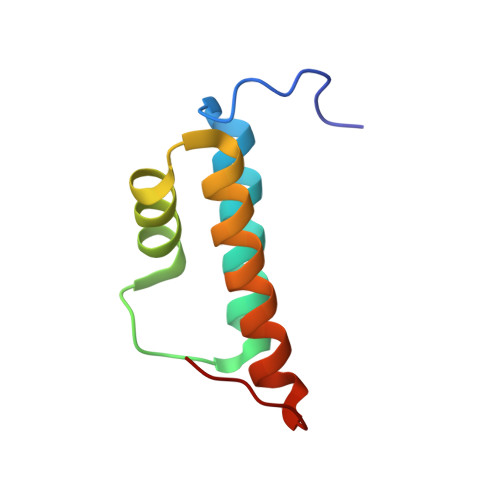An ARC/Mediator subunit required for SREBP control of cholesterol and lipid homeostasis.
Yang, F., Vought, B.W., Satterlee, J.S., Walker, A.K., Jim Sun, Z.-Y., Watts, J.L., Debeaumont, R., Mako Saito, R., Hyberts, S.G., Yang, S., Macol, C., Iyer, L., Tjian, R., van den Heuvel, S., Hart, A.C., Wagner, G., Naar, A.M.(2006) Nature 442: 700-704
- PubMed: 16799563
- DOI: https://doi.org/10.1038/nature04942
- Primary Citation of Related Structures:
2GUT - PubMed Abstract:
The sterol regulatory element binding protein (SREBP) family of transcription activators are critical regulators of cholesterol and fatty acid homeostasis. We previously demonstrated that human SREBPs bind the CREB-binding protein (CBP)/p300 acetyltransferase KIX domain and recruit activator-recruited co-factor (ARC)/Mediator co-activator complexes through unknown mechanisms. Here we show that SREBPs use the evolutionarily conserved ARC105 (also called MED15) subunit to activate target genes. Structural analysis of the SREBP-binding domain in ARC105 by NMR revealed a three-helix bundle with marked similarity to the CBP/p300 KIX domain. In contrast to SREBPs, the CREB and c-Myb activators do not bind the ARC105 KIX domain, although they interact with the CBP KIX domain, revealing a surprising specificity among structurally related activator-binding domains. The Caenorhabditis elegans SREBP homologue SBP-1 promotes fatty acid homeostasis by regulating the expression of lipogenic enzymes. We found that, like SBP-1, the C. elegans ARC105 homologue MDT-15 is required for fatty acid homeostasis, and show that both SBP-1 and MDT-15 control transcription of genes governing desaturation of stearic acid to oleic acid. Notably, dietary addition of oleic acid significantly rescued various defects of nematodes targeted with RNA interference against sbp-1 and mdt-15, including impaired intestinal fat storage, infertility, decreased size and slow locomotion, suggesting that regulation of oleic acid levels represents a physiologically critical function of SBP-1 and MDT-15. Taken together, our findings demonstrate that ARC105 is a key effector of SREBP-dependent gene regulation and control of lipid homeostasis in metazoans.
Organizational Affiliation:
Massachusetts General Hospital Cancer Center, Building 149, 13th Street, Charlestown, Massachusetts 02129, USA.














